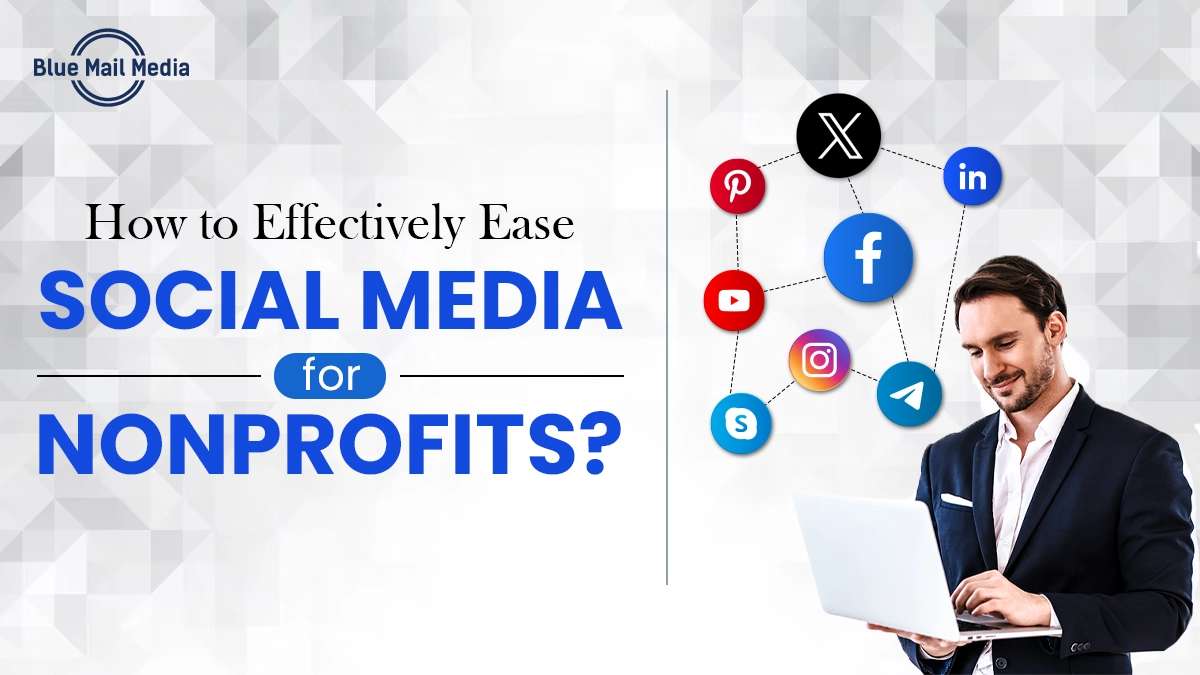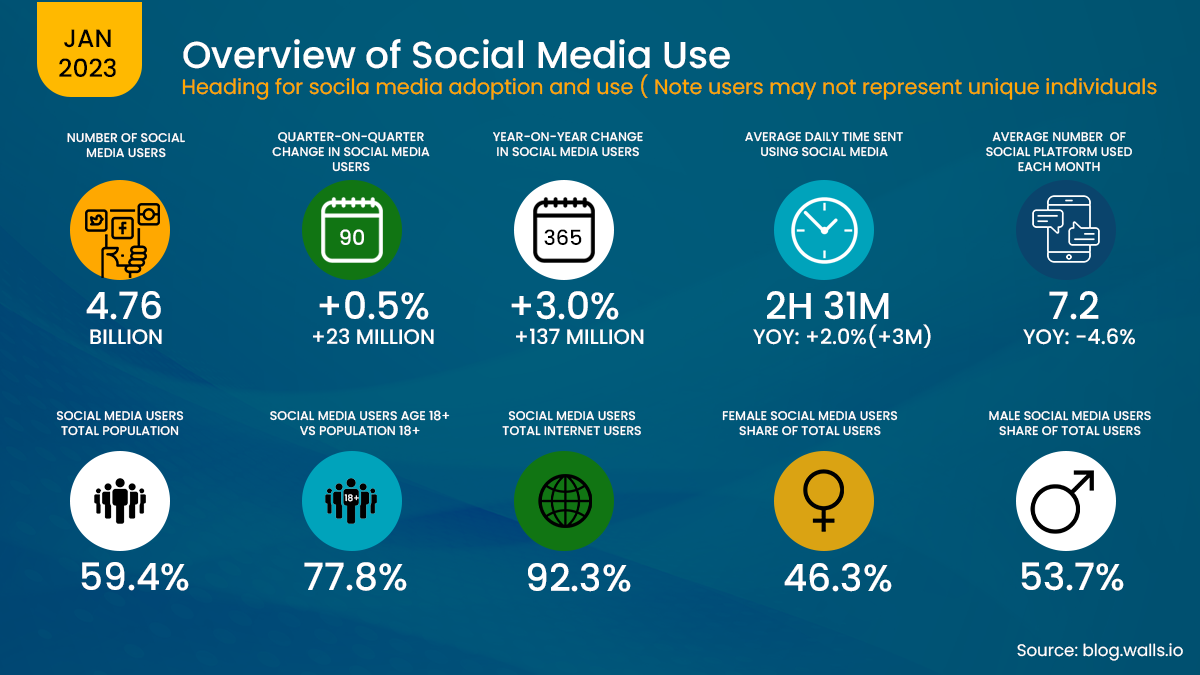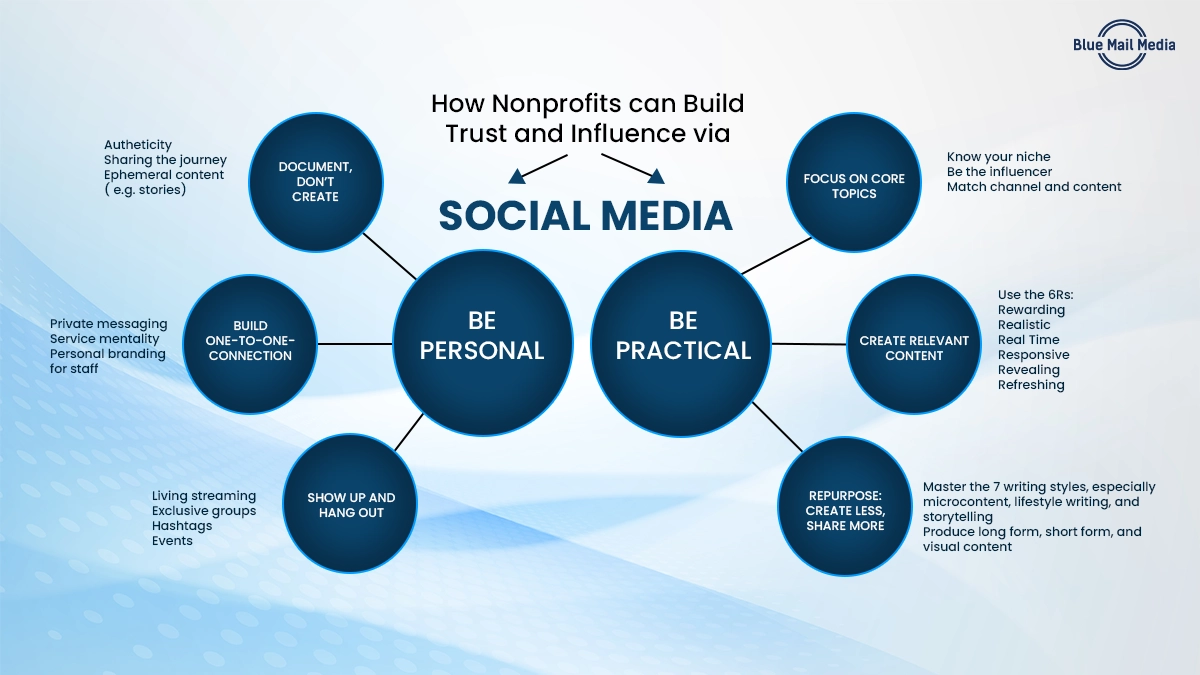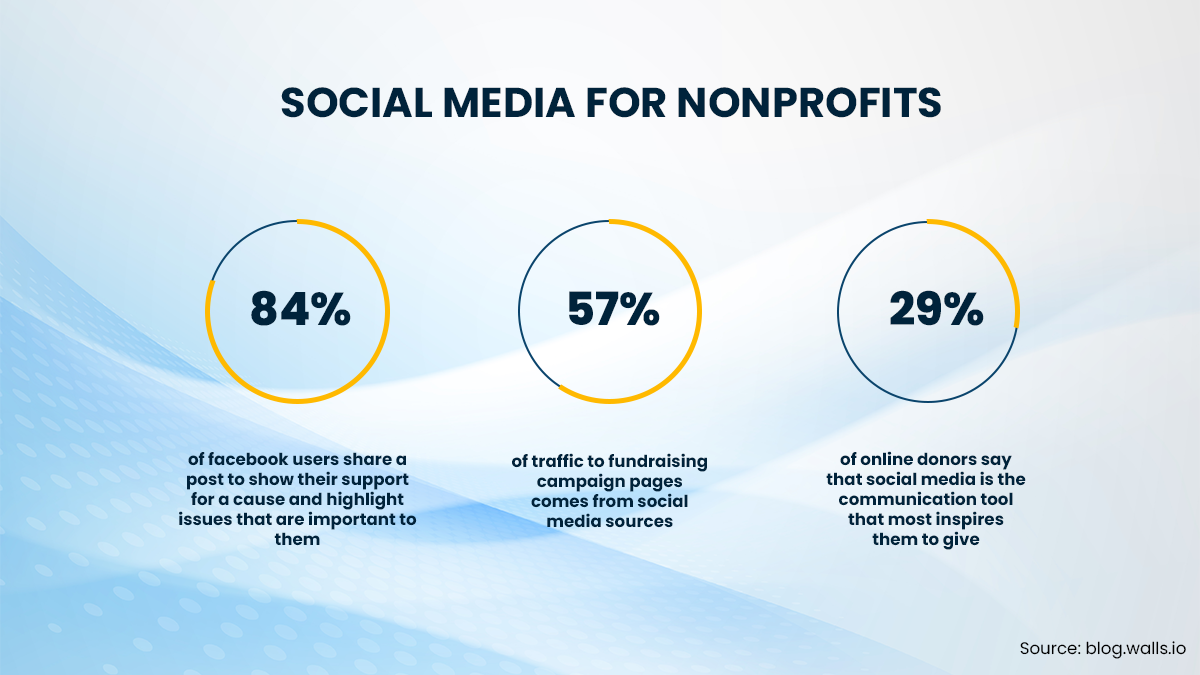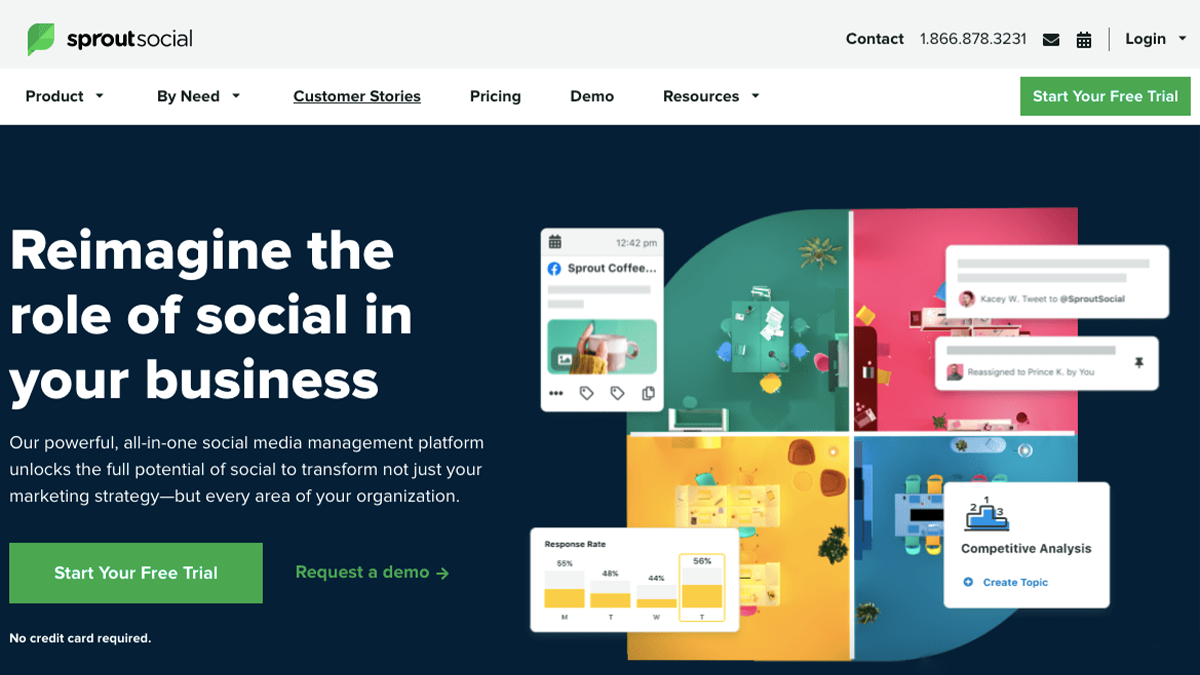With nearly 4.76 billion users worldwide, social media have become integral to any organization’s strategy to attract, engage, and convert prospects. Even nonprofit organizations have rapidly increased social media usage to attract new donors and promote their work. Social media allows nonprofits to connect with potential followers and strengthen relationships with existing supporters.
Notably, one in four donors prefers social media communication from nonprofits and 25% are inspired to donate when social media is the communication channel.
This blog covers the essential aspects of social media for nonprofits, including benefits, practices, and tools.
Benefits of Social Media for Nonprofits
Generally, nonprofits have limited resources and funds that restrict them from spending large amounts on advertising. Social media can support nonprofits to access a massive potential client to spread the word about their cause without spending much. Social media can help achieve the following:
- Promotes Awareness: Around 28% of social media users use the channel to see what is being discussed, while another 3% use it for inspiration. So, social media for nonprofits is an ideal way to spread the word about the organization’s cause, including events to promote it.
- Fundraising: Social media for nonprofits supports the fundraising drive. Individuals that follow the nonprofit and engage with the posts will be willing to support the cause with funds. Add donation links in the post, stories, and bios to make the process easier.
- Connect with New Clients: Social media allows nonprofits to meet new people and form new connections. Sharing their work on social channels enables nonprofit organizations to pique the interest of prospective supporters.
- Communicate Quickly in Crisis: On average, a user spends two hours and thirty-one minutes on social media daily. As such, the platform makes it easy for nonprofits to quickly communicate potentially life-saving information in times of crisis.
Tips to Create a Social Media Strategy for Nonprofits
Social media supports nonprofits in defining the success of their mission. However, with the changing algorithms of social channels, it becomes difficult to secure a position at the top of supporters’ feeds.
A well-established social media strategy for nonprofits is required to overcome these challenges. Here are some of the best tips to create a strong strategy:
1. Define Goals for the Social Media Strategy
The first step to creating a social media strategy for nonprofits is identifying marketing goals.
Nonprofits can use the “SMART” framework to set the goals for their social media strategy, as it will allow them to measure the results. A SMART goal is:
- Specific: Define a clear, specific goal the nonprofit is trying to accomplish
- Measurable: Make sure the goal is measurable to track progress, which helps you stay focused and meet deadlines.
- Attainable: Create a realistic goal. A nonprofit must consider its time, resources, and budget, as they will significantly influence its work.
- Relevant: Ensure the goal reflects the organization’s mission and social media purpose.
- Timely: Defining goals with time-based deadlines allows nonprofits to keep the campaign on track and complete tasks on time.
2. Identify Target Audience and Build Buyer Persona
When planning the marketing strategy, understanding the target audience is vital to creating successful social media content that resonates with the audience. Before diving into social media marketing for nonprofits, it is crucial to identify the NGO’s audience by collecting demographical information, including gender, age, interests, and nationalities. These details will help set the tone of social media content and advance interaction.
3. Choose the Right Platforms
Once nonprofits have defined the ideal audience, they should decide on the social media channels to establish a presence. Each channel shares its unique audience demographics, and not every channel can fit the nonprofit well.
For instance, if a nonprofit audience is majorly millennials, Facebook is a good choice as millennials use the platform 69% more than other audiences.
It is suggested to start social media marketing for nonprofits with one or two platforms and then expand gradually.
4. Set up the Social Media Accounts as Nonprofit
Most social media platforms offer special perks to nonprofit organizations. For instance, nonprofit accounts have built-in production resources, fundraising tools, and dedicated technical support. These accounts even provide analytics, which helps track progress online. Hence, it is essential to register yourself with nonprofit accounts.
Here are a few social media accounts for nonprofits to consider:
- YouTube’s Nonprofit Partner Program features special optimization features designed especially for nonprofits
- The TikTok for Good Program offers account management assistance, hashtag campaign support, and advanced analytics.
- Facebook and Instagram fundraising tools help raise funds.
5. Establish Social Media Guidelines and Policies
Before using social media, setting up guidelines and policies is essential. That way, nonprofits can maintain their brand voice while mitigating risks on social media.
A social media policy will define the code of conduct that dictates how employees should behave online. It primarily includes security protocols, copyright laws, or confidentiality agreements.
Guidelines cover brand positioning style, voice and tone, and visual identity that helps define personality. For instance, some nonprofits may prefer a playful and humorous voice. In contrast, others emphasize formal and professional language.
6. Create a Content Calendar
A well-planned and organized social media content calendar defines content themes and posting cadences to match each specific social media channel audience and goals. It helps reduce creative load, stay organized and decrease the chance of missing postings.
Organizations can easily create a content calendar with automated social media tools. These even allow them to integrate all social media accounts.
7. Embrace Social SEO and Hashtag
Finding new supporters is a prominent goal for nonprofits that can be effectively achieved with social search optimization and proper hashtags.
Prospects actively search social channels for specific information – product reviews, local businesses, brand recommendations, and more. Social SEO is adding text-based features like alt-text, captions, and closed captions to posts to make it easier for potential audiences to find you online.
Moreover, nonprofits, by ensuring that their account bios and captions include keywords and relevant hashtags, can further improve visibility and growth on social channels.
8. Track and Measure Your Results
Tracking and measuring results is essential in social media strategy for nonprofits to recognize failed and successful strategies and content. Nonprofits can rely on social media analytics tools to learn what resonates with the target audience and what is failing to make an impact. With these insights, they can find more effective social media ideas for nonprofits to enhance performance.
Popular Social Media Platforms for Nonprofits
While there are many social media channels available, these are the most popular channels used by nonprofits:
1.Facebook
Having a primary demographic audience between 25 and 34, Facebook offers several benefits to nonprofits:
- Nonprofits can easily set up fundraising campaigns and receive donations online. They can also create a donation button on their posts, ads, and profiles.
- There is also the possibility to stream live videos and broadcast events a nonprofit organization holds. Live events offer supporters real-time updates on the fundraising event.
- NGOs can improve page visibility and generate more donations by utilizing the hashtags potential donors use in their Facebook posts.
2. Instagram
With around 1 billion active users, it’s difficult to ignore the potential Instagram can offer to a nonprofit. It allows them to:
- Generate more followers by hosting interactive question-and-answer sessions with Instagram stories and livestreaming help.
- Incorporate donation buttons or stickers to Instagram profiles or stories to encourage donations or host a live fundraising event.
3. LinkedIn
LinkedIn helps nonprofits contact professionals involved in philanthropy and social responsibility. Most of the large enterprises focus on donations and charities, often run by their employees who have a presence on LinkedIn. Nonprofits can use the platform to network with these individuals and acquire supporters for their cause.
- Take advantage of LinkedIn to join several groups relevant to your initiative. Post regularly in these groups to create visibility and develop more connections.
- With LinkedIn Live, nonprofit organizations can host panel discussions or events to establish networking with key figures and leading enterprises.
- Nonprofits can establish authority and expand awareness by posting frequently on LinkedIn about their cause and sharing insights about their work.
Best Social Media Tools for Nonprofits
Given below are some of the most effective social media tools for nonprofits:
1. Hootsuite:
One of the most widely sought-after and popular social media management tools, Hootsuite offers 50% off on all of its plans for nonprofits. It supports organizations to manage presence from all major social networks on one dashboard. It allows them to schedule up to 350 social media posts at once. More importantly, Hootsuite can track the responses an organization receives on its posts.
2. Buffer:
Buffer is another social media tool for nonprofits that allows them to schedule posts for all major social media channels. The tool offers access to analytics and reports that help identify what content is working and what needs tweaking. Buffer offers 50% off on its plans to nonprofits.
3. Sprout Social:
Sprout Social proudly shares partnerships with social media platforms like Instagram, Facebook, LinkedIn, and Twitter. The software’s best feature is its ability to handle all Direct Messages in one place. Moreover, it supports organizations to schedule and publish posts, collaborate with content teams, and fetch valuable reports on social media accounts.
How Can Nonprofits Rely on Data to be More Successful?
A significant advantage of social media for nonprofits is the ability to collect real-time data and analyze it for insights.
Social media data can help gauge a campaign’s initial success within a few hours of its launch. Over time, it offers a more detailed look into the organization and industry to help maximize time and resources in social media marketing.
Social Media Provides Nonprofits with the Following Data:
- Number of comments, shares, views, or likes on posts
- Demographics of supporters
- Impressions and video views
- Follower count and growth with time
- The time when followers engage with posts most
- Number of actions the audience takes after viewing the posts
- Conversions that take place
Once nonprofits compile this data, they can use it to develop their future social media strategy. They will be able to create content that matches the audience’s interest. Moreover, they can better adjust the content calendar to post content when their followers are most active for better reach and results.
Bottom Line
Social media for nonprofits is essential to find success online. Incorporating social media strategies allows nonprofits to reach a wide audience, build trust, promote awareness of their cause, and raise funds.
To start with social media strategy for nonprofits, organizations should define a SMART goal, learn about the target audience, choose the right platforms, and establish social media guidelines and policies before creating posts.
Setting up a content calendar and embracing social SEO will help improve performance.
Over time, nonprofits will be able to learn what content works in their community and how to fine-tune their social media strategy to get the best outcomes.
As a nonprofit, if your goal is to enhance your donor base or boost networking, Blue Mail Media can help you achieve goals with reliable marketing data solutions! Connect with us for more information.

